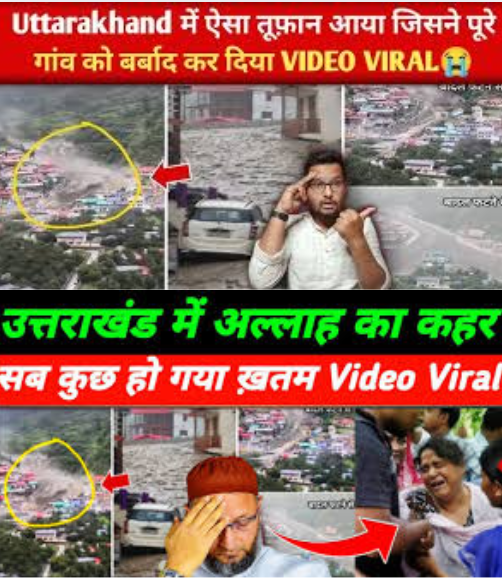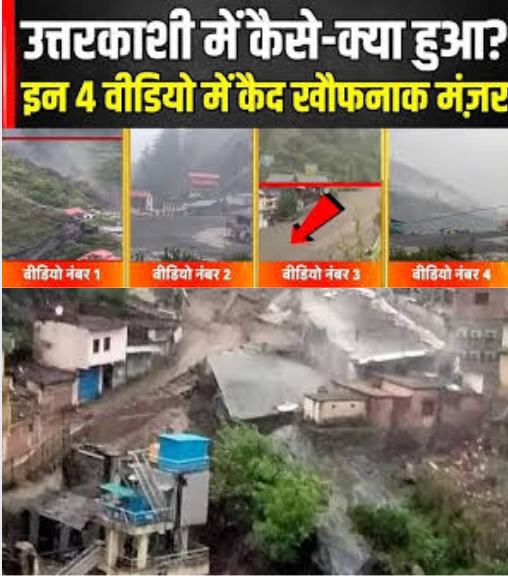Uttarakhand Cloudburst Viral video News😱 Such a storm came in Uttarakhand that destroyed the entire village
A sudden flash flood has wreaked havoc in a small village nestled in the hills of Uttarakhand, leaving behind a trail of unimaginable destruction. The natural disaster, which struck without warning, has not only flattened homes and markets but also disrupted lives, livelihoods, and the very spirit of the local community. Several harrowing videos captured by villagers have surfaced online, showcasing the raw terror and emotional devastation of those who witnessed the catastrophe unfold before their eyes.
What was once a thriving mountain village has now turned into an unrecognizable expanse of mud, debris, and broken dreams. The visuals, shot by terrified locals, paint a grim picture. Loud roars of water, crashing sounds of collapsing buildings, cries for help, and desperate attempts at rescue echo through the videos. Entire markets, religious places like the Kalp Kedarnath temple, and homes were swept away in minutes, leaving no trace behind.
In one of the viral clips, a local voice can be heard saying, “You can’t even tell where the village used to be. Our market is completely gone. The Kalp Kedarnath temple—it’s like it never existed here.” The man filming, standing amid the wreckage, points out that there’s nothing left to identify the place, not even the structures that were just there days ago. The pain and disbelief in his voice reflect the collective trauma of an entire community.
Another video captures a moment of sheer panic. As the debris continues to rush down the valley, a group of people yell warnings to each other: “It’s coming again! Move! It’s coming back!” Some shout out directions, trying to help others escape, while others stand frozen, shocked by the recurring waves of destruction. “This is a terrifying situation,” says one man, clearly shaken, “It’s all debris everywhere. There’s nothing left.”

According to eyewitnesses, the flash flood occurred with no time to prepare. Locals say the early morning rains intensified rapidly, and within a short span, what started as a storm turned into a deadly torrent of water and rocks crashing down the mountainside. In some cases, people saw their homes collapse in front of them; in others, they fled with only the clothes on their backs.
The devastation has been so severe that many residents are still missing, and rescue efforts have been challenging due to the continuous flow of debris and the remoteness of the area. Roads have been cut off, bridges have collapsed, and communication networks have been disrupted, making it difficult for help to reach in time.
Local authorities have begun emergency response operations, but villagers are also relying on one another for support. Makeshift shelters have been set up, and those who lost everything are receiving food and water from nearby towns. The Indian army and disaster relief teams have been called in to assist with rescue and rehabilitation efforts.
“This is the worst disaster we’ve seen in years,” a local rescue worker said. “We are doing our best, but we need more support from the state and central government.”
The loss is not just material. Many villagers are mourning the loss of family members, neighbors, and the life they had painstakingly built over generations. “We saw everything fall apart right in front of us,” one woman said, her voice cracking. “How do we even begin to start over?”
Social media has played a critical role in bringing this tragedy to national attention. The viral videos have stirred emotional reactions across the country, with thousands expressing grief, solidarity, and offering prayers. Hashtags like #PrayForUttarakhand and #UttarakhandFloods are trending, as netizens urge authorities to step up relief efforts and provide long-term support to the affected communities.

Environmentalists and climate experts are also weighing in, pointing out that such extreme weather events are becoming more frequent in the Himalayan region. They warn that deforestation, unregulated construction, and climate change are amplifying the impact of natural disasters. “The mountains are fragile,” a climate scientist wrote on social media. “If we don’t respect the environment, these tragedies will keep repeating.”
This is not the first time Uttarakhand has been hit by such calamity. The region, known for its beauty and spirituality, has often found itself at the receiving end of nature’s fury. From the 2013 Kedarnath floods to numerous landslides and cloudbursts over the years, the residents have grown used to facing the wrath of nature—but nothing prepares one for the magnitude of destruction seen in the current disaster.
As the sun sets over the debris-strewn village, hope remains the only flicker of light for the survivors. Families cling to each other, some still searching for loved ones, others grieving for what they’ve lost. Their strength in the face of such adversity is a testament to the resilience of the human spirit.
This tragedy is a sobering reminder of how vulnerable mountain communities are to natural disasters, and how urgent it is for all stakeholders—governments, scientists, and citizens—to come together to create sustainable, disaster-resilient solutions for the future.
For now, the message is simple and clear from those affected: Pray for Uttarakhand. Pray for the lives lost. Pray for the survivors. And most importantly, don’t look away.
Play video :
News
Sad news for Shehnaaz Gill Fans as as Shehnaaz Gill Hospitalized after serious condition is in ICU!
Sad news for Shehnaaz Gill Fans as as Shehnaaz Gill Hospitalized after serious condition is in ICU! In an emotional…
Ekta Kapoor Fight With Leading Actor At Kyunki Saas Bhi Kabhi Bahu Thi Set
Ekta Kapoor Fight With Leading Actor At Kyunki Saas Bhi Kabhi Bahu Thi Set After a hiatus of over two…
Hina Khan Worst Condition, Cancer Spreads Again after Multiple Treatments & Surgeries
Hina Khan Worst Condition, Cancer Spreads Again after Multiple Treatments & Surgeries . . . Hina Khan’s Health Worsens: Cancer…
Salman Khan visited the hospital to see Shura Khan blessed with baby boy
Salman Khan visited the hospital to see Shura Khan blessed with baby boy . . . Salman Khan Visits Hospital…
Bigg Boss fame Shehnaaz Gill admitted to ICU after her Critical Condition admit to Hospital!
Bigg Boss fame Shehnaaz Gill admitted to ICU after her Critical Condition admit to Hospital! . . Shehnaaz Gill Hospitalized…
The maid revealed all the secrets, now Bharti will have to go to jail | Bharati Singh Controversy
The maid revealed all the secrets, now Bharti will have to go to jail | Bharati Singh Controversy . ….
End of content
No more pages to load











